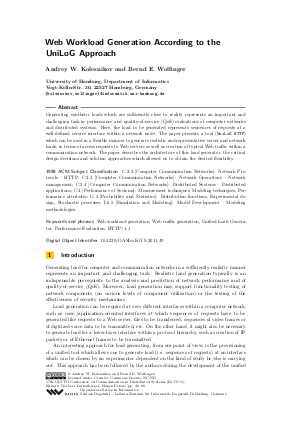Web Workload Generation According to the UniLoG Approach
Authors Andrey W. Kolesnikov, Bernd E. Wolfinger
-
Part of:
Volume:
17th GI/ITG Conference on Communication in Distributed Systems (KiVS 2011)
Part of: Series: Open Access Series in Informatics (OASIcs) - License:
 Creative Commons Attribution-NonCommercial-NoDerivs 3.0 Unported license
Creative Commons Attribution-NonCommercial-NoDerivs 3.0 Unported license
- Publication Date: 2011-02-25
File

PDF
OASIcs.KiVS.2011.49.pdf
- Filesize: 0.61 MB
- 12 pages
Document Identifiers
Subject Classification
Keywords
- Web workload generation
- Web traffic generation
- Unfied Load Generator
- Performance Evaluation
- HTTP/1.1
Metrics
- Access Statistics
-
Total Accesses (updated on a weekly basis)
0Document
0Metadata
Abstract
Generating synthetic loads which are suffciently close to reality represents an important and challenging task in performance and quality-of-service (QoS) evaluations of computer networks and distributed systems. Here, the load to be generated represents sequences of requests at a well-defined service interface within a network node. The paper presents a tool (UniLoG.HTTP) which can be used in a flexible manner to generate realistic and representative server and network loads, in terms of access requests to Web servers as well as creation of typical Web traffic within a communication network. The paper describes the architecture of this load generator, the critical design decisions and solution approaches which allowed us to obtain the desired flexibility.
Cite As Get BibTex
Andrey W. Kolesnikov and Bernd E. Wolfinger. Web Workload Generation According to the UniLoG Approach. In 17th GI/ITG Conference on Communication in Distributed Systems (KiVS 2011). Open Access Series in Informatics (OASIcs), Volume 17, pp. 49-60, Schloss Dagstuhl – Leibniz-Zentrum für Informatik (2011)
https://doi.org/10.4230/OASIcs.KiVS.2011.49
BibTex
@InProceedings{kolesnikov_et_al:OASIcs.KiVS.2011.49,
author = {Kolesnikov, Andrey W. and Wolfinger, Bernd E.},
title = {{Web Workload Generation According to the UniLoG Approach}},
booktitle = {17th GI/ITG Conference on Communication in Distributed Systems (KiVS 2011)},
pages = {49--60},
series = {Open Access Series in Informatics (OASIcs)},
ISBN = {978-3-939897-27-9},
ISSN = {2190-6807},
year = {2011},
volume = {17},
editor = {Luttenberger, Norbert and Peters, Hagen},
publisher = {Schloss Dagstuhl -- Leibniz-Zentrum f{\"u}r Informatik},
address = {Dagstuhl, Germany},
URL = {https://drops.dagstuhl.de/entities/document/10.4230/OASIcs.KiVS.2011.49},
URN = {urn:nbn:de:0030-drops-29571},
doi = {10.4230/OASIcs.KiVS.2011.49},
annote = {Keywords: Web workload generation, Web traffic generation, Unfied Load Generator, Performance Evaluation, HTTP/1.1}
}
